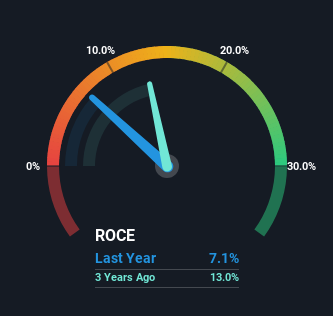- India
- /
- Paper and Forestry Products
- /
- NSEI:ARCHIDPLY
Capital Allocation Trends At Archidply Industries (NSE:ARCHIDPLY) Aren't Ideal
What are the early trends we should look for to identify a stock that could multiply in value over the long term? One common approach is to try and find a company with returns on capital employed (ROCE) that are increasing, in conjunction with a growing amount of capital employed. Ultimately, this demonstrates that it's a business that is reinvesting profits at increasing rates of return. In light of that, when we looked at Archidply Industries (NSE:ARCHIDPLY) and its ROCE trend, we weren't exactly thrilled.
What Is Return On Capital Employed (ROCE)?
If you haven't worked with ROCE before, it measures the 'return' (pre-tax profit) a company generates from capital employed in its business. To calculate this metric for Archidply Industries, this is the formula:
Return on Capital Employed = Earnings Before Interest and Tax (EBIT) ÷ (Total Assets - Current Liabilities)
0.071 = ₹135m ÷ (₹3.3b - ₹1.4b) (Based on the trailing twelve months to June 2024).
Therefore, Archidply Industries has an ROCE of 7.1%. In absolute terms, that's a low return and it also under-performs the Forestry industry average of 12%.
See our latest analysis for Archidply Industries

Historical performance is a great place to start when researching a stock so above you can see the gauge for Archidply Industries' ROCE against it's prior returns. If you're interested in investigating Archidply Industries' past further, check out this free graph covering Archidply Industries' past earnings, revenue and cash flow.
So How Is Archidply Industries' ROCE Trending?
When we looked at the ROCE trend at Archidply Industries, we didn't gain much confidence. To be more specific, ROCE has fallen from 12% over the last five years. However it looks like Archidply Industries might be reinvesting for long term growth because while capital employed has increased, the company's sales haven't changed much in the last 12 months. It may take some time before the company starts to see any change in earnings from these investments.
On a side note, Archidply Industries' current liabilities are still rather high at 42% of total assets. This effectively means that suppliers (or short-term creditors) are funding a large portion of the business, so just be aware that this can introduce some elements of risk. While it's not necessarily a bad thing, it can be beneficial if this ratio is lower.
The Bottom Line
Bringing it all together, while we're somewhat encouraged by Archidply Industries' reinvestment in its own business, we're aware that returns are shrinking. Yet to long term shareholders the stock has gifted them an incredible 418% return in the last five years, so the market appears to be rosy about its future. But if the trajectory of these underlying trends continue, we think the likelihood of it being a multi-bagger from here isn't high.
Archidply Industries does have some risks, we noticed 4 warning signs (and 1 which shouldn't be ignored) we think you should know about.
While Archidply Industries may not currently earn the highest returns, we've compiled a list of companies that currently earn more than 25% return on equity. Check out this free list here.
New: Manage All Your Stock Portfolios in One Place
We've created the ultimate portfolio companion for stock investors, and it's free.
• Connect an unlimited number of Portfolios and see your total in one currency
• Be alerted to new Warning Signs or Risks via email or mobile
• Track the Fair Value of your stocks
Have feedback on this article? Concerned about the content? Get in touch with us directly. Alternatively, email editorial-team (at) simplywallst.com.
This article by Simply Wall St is general in nature. We provide commentary based on historical data and analyst forecasts only using an unbiased methodology and our articles are not intended to be financial advice. It does not constitute a recommendation to buy or sell any stock, and does not take account of your objectives, or your financial situation. We aim to bring you long-term focused analysis driven by fundamental data. Note that our analysis may not factor in the latest price-sensitive company announcements or qualitative material. Simply Wall St has no position in any stocks mentioned.
About NSEI:ARCHIDPLY
Archidply Industries
Manufactures and sells wood and paper based products in India and internationally.
Acceptable track record with imperfect balance sheet.
Similar Companies
Market Insights
Community Narratives



